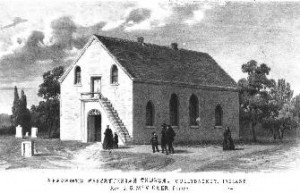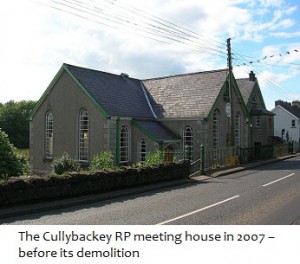History
Click here to listen to a series of talks by Dr. William Roulston, a local historian, about the history of the Reformed Presbyterian Church and about our church in Cullybackey.
The Covenanters of Cullybackey

Covenanters have been meeting for public worship in the village of Cullybackey for over two centuries. 6 December 2008 was a joyous day for the congregation when the new church building was used for the first time. This church was built on the same site as its predecessor which was erected in 1789. However, the story of the Covenanters in the Cullybackey area goes back much further than this.
In the late seventeenth century David Houston ministered to Covenanters over a wide area, including families living in mid Antrim. When he died in 1696 the Covenanters were left without a minister of their own for over sixty years. During these difficult days Covenanters organised themselves into ‘societies’. One of the most important of these was at Laymore. Here was the Round Hole, a natural amphitheatre and the perfect setting for open-air services. This society developed into Cullybackey Reformed Presbyterian Church.
In 1765 Daniel McClellan was ordained a minister of the Reformed Presbyterian Church at the Round Hole and assigned to work at Cullybackey. It was at this time that Cullybackey was established as a separate and distinct congregation. In 1789 a meeting house was built on the present site in the village of Cullybackey. It was situated close to the pound, where stray cattle were rounded up, and so became known as ‘The Pound Meeting House’. This building was a plain rectangular structure with a gallery at each end. Access to each gallery was provided by a stairway on the outside of the gable wall.
The meeting house was built during the ministry of Rev. William Gibson. His ministry ended in 1797 when he was forced to flee to America following his refusal to take the Oath of Allegiance demanded of him by a civil magistrate.

In 1800 Rev. William Staveley, formerly of Knockbracken, was installed as minister of Cullybackey. In 1811 the first Synod of the Reformed Presbyterian Church was held in Cullybackey. At this time Cullybackey was joined with Kellswater. A number of Synods have been held in Cullybackey over the years, Click Here to Read More. However, in 1813 Cullybackey again became an independent congregation. Five years later the Rev. Clarke Houston was installed. In 1824 there were 1,120 people associated with the congregation, 410 of them communicant members.
In 1840, following a split in the denomination over issues relating to the Church’s historic position on political dissent, the congregation joined the breakaway Eastern Reformed Presbyterian Synod. During this time the work of the congregation continued. In 1859 the Rev. John G. McVicker took a deep interest in the Revival and was much in demand as a speaker. In 1887, during the ministry of Rev. Joseph Moody, the meeting house was thoroughly refurbished and enlarged to cope with the increase in the size of the congregation.
In 1905 the congregation was accepted back into the Reformed Presbyterian Church and James A. Lyons was ordained minister. The manse, which had been built in 1854, was renovated and an extra storey was added. Early in Mr Lyons’ ministry the congregation began holding Sabbath evening services in Ballymena. In 1929 a new lecture hall was built at a cost of c.£2,000 and the following year the graveyard was extended. In 1989 the congregation celebrated the 200th anniversary of the construction of the meeting house. However, there was a growing realisation that the existing buildings did not meet the needs of a congregation in the 21st century. In the summer of 2007 the old church and lecture hall were demolished and work began on a new suite of buildings. These were completed in December 2008.
